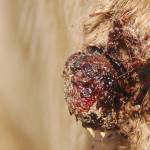Taking a New Stab at Equine Sarcoids

Do you know the largest body system of the horse? That’s right, the integumentary system, which includes the skin, hair, hooves, and more. In addition to burns, abrasions, and lacerations, tumors such as sarcoids can negatively impact the health of the skin. Researchers continue to explore new ways to best treat sarcoids.
Sarcoids, the most common neoplasm affecting horses, cause functional, aesthetic, and economical losses. Six distinct forms of sarcoids exist, ranging from occult sarcoids (the small flat gray circular hairless bumps) to the malevolent type (aggressive growths that invade surrounding tissues) and a large variety of lumps and bumps in between.
Current treatments for sarcoids include one or more of the following: surgical or laser excision, cryotherapy (freezing), local immune modulation (Bacillus Calmette-Guérin [BCG] therapy) that essentially tricks the body’s immune system to fight the sarcoid cells to stop tumor growth, local radiotherapy achieved by placing radioactive seeds or needles at the site of the sarcoid, and application of an antiviral cream. Vaccines and other treatment options are also in various phases of development.
One of the biggest problems with sarcoids is their propensity to regrow following treatment, frequently more aggressively than the original tumor. Further, many sarcoids initially thought to be relatively benign can spread once a veterinarian samples or treats them.
According to one group of researchers*, a possible explanation for the exquisitely sensitive nature of sarcoids could be changes in the genes in or near the tumor. Specifically, increased or decreased methylation patterns—which simply refer to either an excess or deficiency of methyl groups (one carbon and three hydrogen atoms)—in specific regions of a cell’s DNA could contribute to the development or spread of tumors.
Based on research in different human cancers, Semik and colleagues from Europe believe that improving their knowledge of methylation patterns in specific sarcoid cell genes will help drive the development of better diagnostic and treatment tools. In turn, veterinarians will then be able to minimize the recurrence and spread of sarcoids.
“In addition to daily grooming, offering a balanced diet combined with a nutritional supplement containing adequate vitamins and minerals such as biotin, methionine, zinc, and iodine will support the health of the integumentary system,” explains Kathleen Crandell, Ph.D., a nutritionist with Kentucky Equine Research (KER).
Sarcoids are equal opportunity growths, and sometimes even the best-groomed, well-fed horses fall victim.
Examples of beneficial nutritional supplements to support healthy skin include Bio-Bloom PS (Bio-Bloom HF in Australia) and long-chain omega-3 fatty acids found in fish oil products such as EO•3. Fish oils also have natural anti-inflammatory properties that could benefit horses with sarcoids or other skin tumors.
*Semik, E., T Ząbek, A. Gurgul, et al. Comparative analysis of DNA methylation patterns of equine sarcoid and healthy skin samples. Veterinary and Comparative Oncology. In press.








